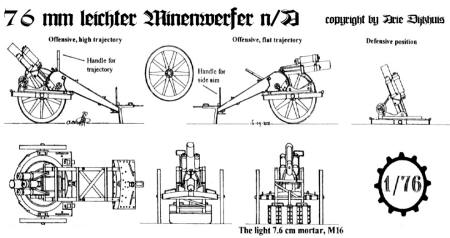
07-07-2009, 01:47 PM
|
 |
Administrator
|
|
|
|
 7.58cm leichter Minenwerfer (2)
7.58cm leichter Minenwerfer (2)
The German army had, contrary to the British army, foreseen the new order of warfare, and had invested in the development of trench mortars. From 1914 onwards these ‘Minenwerfer’ wreaked havoc amongst the Allied lines. The first types were mostly simple in design, and often only intended as a stopgap. In 1916 the German artillery was reorganised, and with this came new weapons. The old ‘Minenwerfer’ were replaced by a new generation. These were the heavy 25 and 24-cm mortars, the medium 17-cm mortar, and the light 7.58-cm mortar. To this range, the light M16 grenade thrower (see Tankette 31/6) was added to further strengthen of the offensive and defensive power. There were 2 different types of ‘Minenwerfer’‑companies. The first was equipped with the light types of weapons, and the second with medium and heavy mortars. I will confine myself to the first type. These were normally organised in an Abteilung consisting of 12 light mortars and 24 grenade throwers per infantry regiment. Stormtrooper battalions usually had a mortar company of their own. They followed soon after the first wave of shock troops and their equipment including the 7.58cm ‘Minenwerfer’ and the lighter M16 grenade thrower. Both guns did not fire during the preparation phase before the battle.
|
| | 7.58cm Leichter Minenwerfer n/A (neuer Art or new type) | | This is the redevelopment of the M10 light mortar. The main improvement of this weapon lay in the fact, that it was placed on a turntable. This gave the gun a field of fire of 360 degrees. Also the length of the barrel was increased. The gun, which was introduced in 1916, had a tail fitted to it, so it could be used as a flat-trajectory weapon as well. This enabled the gun to knock out strong points or even tanks by using direct fire. This tail (along with the wheels) could be removed when the gun was in a defensive position. The addition of this tail increased the gun's weight to 150 kg. The M16 mortar was capable of firing the old light HE shells. This meant that the piles of old ammo could still be used effectively. Its maximum effective range was 1 km, which was the same as the old version of the 7.58cm mortar. In addition to this, it could also fire the new 1916 light HE shell. This shell increased the field of fire to 1,300 meters. It also fired the Light gas shell over the same range. All shells weighed 4.5 kg. The crew of this gun was normally 2 gunners, 2 loaders and one NCO, but to move it over rough ground at least 6 men were required, according to the manual. This was probably the full gun (with tail) and infantry ‘Handkarre’, the ammo handcar. One of these was enough to equip the gun with several rounds.
Calibre: 7,58cm
Barrel length in calibres: 5,5
Weight: 250 kg (with tail) or 140 kg (without tail)
Range of fire: 875 m (with tail) or 1.300 m (without tail)
Weight of shell: 4,5 kg
These drawings (click to enlarge!) were made from measurements and pictures taken in the Koninklijk Belgisch Legermuseum in Brussels, De Lakenhal in Yper, Musee la Grande Guerre in Perrone, Hill 62 Museum near Yper, Wehrtechnisches Museum in Koblenz, Sachsisches Armee Museum in Dresden and the Imperial War Museum in Duxford.

|
| | 9.15cm Leichter Minenwerfer System Lanz
9cm Minenwerfer M.14 | | The Lanz was produced as a stop gap weapon in the early years of the war to fill the need of a grenade thrower. This was called a Behelfsminenwerfer, from the fact that it was ordered by the army as an interim weapon. It entered service in 1915. Produced by Heinrich Lanz of Mannheim, it is a very simple construction, fairly light, and able to do what it was designed for. It was entirely made from sheet metal and wood. As far as I know, it stayed in service throughout the war. It fired a light high explosive shell. I am not too sure if it also fired gas shells, but it is not unlikely. The fuses were either direct or with a delay. These weapons were also used by the Austrians (under the designation 9cm Minenwerfer M.14, and was the mainstay of the Austro-Hungarian mortar squads in the Infantry Regiments Heavy Coy's) and even the Italians used a version of their own.
Calibre: 91,5mm
Barrel lenght in calibres: 6,5
Weight: 106 kg
Range of fire: 320m (glatte leichte Wurfmine) or 450m (Granatmine)
Weight of shell: 3,8 kg (glatte leichte Wurfmine) or 3.5 kg (Granatmine)
Explosive charge: 360 gr (Wurfmine) or 375 gr (Granatmine)
These drawings (click to see the full version) were made from measurements and pictures taken in the Musee de la Victoire in Verdun and the Koninklijk Belgisch Legermuseum in Brussels.

|
| |


|





 Similar Threads
Similar Threads

